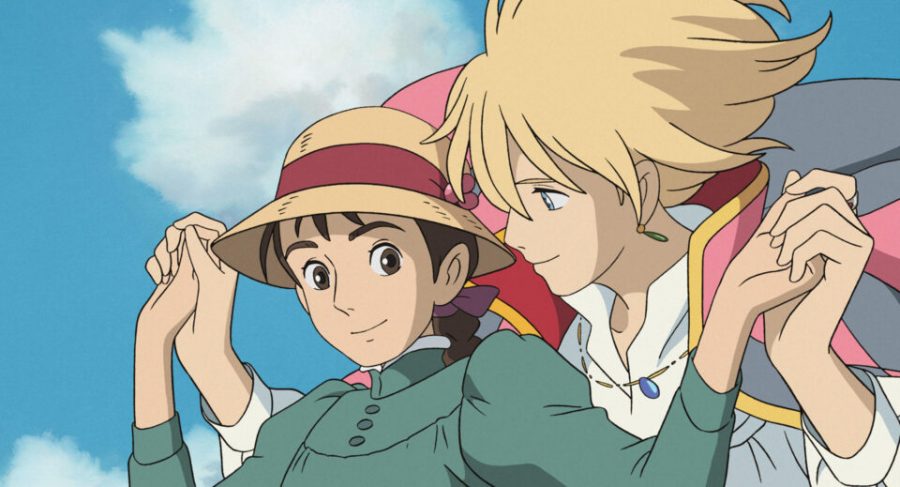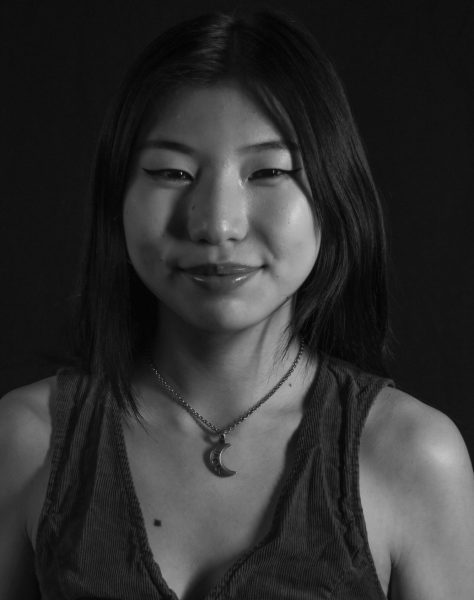Analyzing fashion in Howl’s Moving Castle
November 18, 2021
Studio Ghibli’s film “Howl’s Moving Castle” (2004) remains a prominent piece of media in the realm of animation, winning various accolades at the 61st Venice International Film Festival and Mainichi Film Awards in 2004. Set in a fictional kingdom, the movie showcases both magic and early 20th-century technology against the backdrop of a war with another kingdom. The film centers on a young, female protagonist named Sophie Hatter; cursed by a witch known as the Witch of the Waste, she crosses paths with Howl Pendragon, a somewhat notorious wizard whom she gradually falls in love with throughout the film. The global fascination for “Howl’s Moving Castle “ often stems from fans’ love for the nuanced plot and symbolism, animation and musical themes that characterizes the studio’s unique style of cinematography. One of the most significant aspects of the film, however, is the impact of fashion on the setting as well as in the development of the plot and characters. It plays an essential role in shaping the nature of Ghibli films and supporting the growth of the major protagonists, Sophie and Howl.
Historical Background
The historical context of “Howl’s Moving Castle” is critical in providing a foundation for the actual fashion of the movie’s characters. The combined imagery of the steam-powered cars, trolleys, trains and behemoth military aircraft frequently shown throughout the film illustrates that “Howl’s Moving Castle” takes significantly from the steampunk genre as well as its subgenre “Gaslamp Fantasy.” Defined as a subgenre of science-fiction, steampunk involves a world that incorporates technology and aesthetic designs inspired by 19th century industrial steam-powered machinery in a Victorian or Edwardian setting. In the film’s case, the Edwardian setting is represented. Gaslamp fantasy additionally incorporates elements from the genres of historical fiction and fantasy, which better encompass both the human machinery and magic that coexist in the film. The anime draws parallels between the burgeoning war at the beginning of the movie and the pre-World War I Edwardian era (1901-1910) by incorporating this period’s technological advancements and fashion into the film. Studio Ghibli used steampunk and military tropes embedded in a world based on Victorian visual elements as well as incorporating French, German and Austrian architecture to create a representation that demonstrates the Edwardian era.
Edwardian Fashion
Women’s fashion of the late Victorian and Edwardian Era was becoming more elaborate in color as well as design, different from its predecessors that focused on a darker range of fabrics. Higher necklines, blouses, slim sleeves with shoulder poufs and dramatically large hats characterized Edwardian fashion. This era of fashion focused more on the natural waistline with the s-shape silhouette that pushed the hips back and the bust forward. With the 1870s Victorian bustle era coming to a close, a lighter, blousier style was in fashion. In the film, Sophie’s mother, Honey Hatter, wears Edwardian-like clothing. Her yellow dress is reminiscent of the popular gowns at the time, with its puffy leg-of-mutton sleeves, high collar and natural waistline to accentuate the shoulders, as well as the addition of a bow belt and decorative wide-brimmed hat, which were both popular accessories at the time. Honey, being the owner of a hat shop that previously belonged to Sophie’s father, further emphasizes the unique importance of the accessory at the time. Sophie’s sister, Lettie, wears a very similar dress to her mother’s but in an elaborate pink. When Sophie goes to the royal palace in Kingsbury later in the movie, the common people there wear similar designs. Men wear suits and top hats and women wear Edwardian dresses and hats adorned with bows, feathers and parasols to depict a neo-Victorian setting.
Impact of Fashion on Sophie’s Development
At the beginning of “Howl’s Moving Castle,” Sophie Hatter is first seen wearing a sun hat with a red ribbon, a pink brochette and a pastel green dress with a white collar. After Sophie is cursed, she continues to wear the same hat with her hair in a braid alongside a blue dress, designed similarly to the green, and a long-skirted yellow dress by the very end of the film. Sophie’s dress is reminiscent of a day dress from the 1890s that takes from older Victorian wrappers. In the film, she actually mentions that right after she is cursed into a much older version of herself, her clothing “finally suits her,” indicating she dresses rather “old” for her age. With a later Edwardian period as the setting, it would make sense for Sophie to describe a Victorian wrapper-like dress as old-fashioned. At the beginning of the story, Sophie’s character is shy and quiet, believing herself to be ugly. Unlike her mother and her sisters, Sophie tends to dress more reservedly in clothes that do not resemble the popular fashion of the time. Her clothing reflects the view she has of herself as having a place only in relation to the people around her instead of having a distinct place of her own. Her dresses throughout the film are all quite similar to one another as iterations of the same dress, the only significant difference being in color. The selected range of garment design was intentional so that Sophie’s dress essentially became part of her character. When her dress became a solidified piece of her character design, the garment did not have the ability to further influence how she developed, but rather she herself determined the worth and level of importance of the dress. The dress being seemingly plain as well allowed it to accompany Sophie’s journey into her character development. The dress’s design worked alongside Sophie’s personality and her growth as a character. The article “Fashion Analysis in Hayao Miyazaki’s Films” by Darlyn Granja describes how it goes from being a simple dress to “a symbolic piece that is shaped and personalized by Sophie and her character development, rather than the dress shaping Sophie.” The gown itself did not provide beauty for Sophie. Instead, her growing self-assurance resonated in her clothing.
When it came to the accessories Sophie wore, she always opted for her simple straw sun hat even as she, a hat maker, had made many decorative, luxurious hats that were a rage amongst popular Edwardian fashion. The hat not only indicates Sophie’s quiet personality but also displays her view of the world. She believes beautiful things do not belong to her and are instead things that have always been, and will continue to be, around her. The audience can see the hat as a metaphor for the burden she carried on herself—the weight of insecurity, the weight of carrying on with her father’s shop as well as the weight of the lack of freedom she felt in her own life. Burdened by insecurities and obligations as the eldest daughter of her family, Sophie, still a young teenage girl, “chose” to stay at the hat shop to feel as though she had some sense of autonomy over her life and feel within reason to take up her own space in this world. In the first few minutes of the movie, Sophie is about to visit her sister Lettie. She looks at herself in the mirror of the hat shop, and for a few seconds, she smiles at her reflection before hastily pulling down her hat with a frown. This symbolizes her dissatisfaction with seeing herself within the realm of her hat shop, as well as her self-enforced content with the simple hat she chose to wear. When Sophie was cursed into an old woman, her new appearance actually liberated her from the inferiority she felt from her helplessness. Although her body may have felt the physical aches and pains of being an old woman, she found an authority within herself that her young form felt she did not possess. Now cursed, Sophie could not have stayed at the hat shop even if she wanted to. Meeting Howl and traveling in his moving castle instilled courage and confidence within Sophie, specifically shown through her conversation with Madame Sullivan, the film’s main antagonist, and then her escape. As Sophie released her hesitancy in that moment, the weight lifted from her shoulders, her hat flew off and she no longer had to hold herself back from going on the adventure that her heart desired. Her escape to Howl’s moving castle became the embodiment of her true beginning.
The Fashion of Howl
Fashion as a persona was a central part in illustrating Howl’s initial character in the film as well as laying the foundation for his future development. In the expository sequence of the movie, the other employees of Sophie’s hat shop first mention Howl when they describe him to be a malicious wizard who “tears girls’ hearts,” particularly preying on pretty girls. He is then physically introduced only about two minutes later in the film. He has dyed blond hair and wears a shirt adorned with frills and a diamond-patterned jacket that sits on his shoulders, an intentional stylistic choice to make his figure appear bigger than he actually is. In this scene, he is represented as kind and even gentle for both helping Sophie escape the two predatory soldiers and quickly guiding her to Lettie’s workplace. In the following conversation between Sophie and Lettie, Sophie describes Howl as “so kind,” while Lettie scolds and warns her of his imminent danger —the possibility of Howl eating her heart. This introduction sequence already begins to illustrate what is central to Howl’s conflict throughout the movie, in which two sides of him continue to clash and blend with one another. One half is the “Wizard Jenkins” he had essentially created to be perceived by others, and the other half is the cowardly and immature, but also good-intentioned human being Sophie and viewers found him to be toward the end of the film. His reputation was cultivated while he was trying to hide from his fear of losing freedom, as he was forced by Madame Sullivan to use his magic to intervene in the ongoing war introduced in the beginning of the movie. Howl’s beauty was one to draw the public’s attention and makes him the subject of gossip, but him avoiding visibility as much as possible allows both his reputation to precede him as an individual and for others to fill in the rest of what they do not know. This explains why he is known for being a malicious wizard who “tears girls’ hearts.” This reputation further contributes to his own vanity and obsession with his looks, as physical appearance is a significant part of creating a superficial image for others to judge. When Sophie was quickly settling into the castle, for example, Howl threw a childish-like tantrum over his allegedly lost beauty after his blonde hair turned orange and then eventually black as a result of Sophie tampering with his cosmetic potions.
Miyazaki sets Howl up to be a steampunk hero to a certain extent at the beginning of the film. Steampunk imagery is dominated by what the Nordic Journal of Science Fiction and Fantasy Research describes as the aesthetic of “the tinkerer, the explorer and the adventurer” which can represent both him, his advanced magic and his moving castle. Howl possesses some of those idealized features, but also shows flaws, such as vanity and temper, that further demonstrate his strive to be human rather than anyone’s particular hero. Audiences later discover Howl has no heart due to a deal with Calcifer, the resident demon of the moving castle, which explains his dramatic and child-like tendencies. He wasn’t deliberately forced to grow up and take real responsibility for his actions. As the movie reaches its climax, Howl wears a simple peasant blouse, no suit and his hair is back to its natural black color. Howl’s increasingly natural appearance hints he is gradually unmasking his façade and becoming more aligned with his true self because of his love for Sophie. Sophie slowly became the defining center of Howl: the center between his two previously clashing identities. This is further evident when he confesses his love for her while he is in his swallow/monster form. His swallow form embodies both how his superficial image has been warped and twisted by war, fear and exploitation by the ruling class but also how in light of this, the “monster” was really the human he had finally realized within himself. Much like his castle, Howl is a beautifully chaotic yet enchanting being.
Overall, the fashion present in “Howl’s Moving Castle” acted as a critical component to building nuance to the personal as well as romantic development of the protagonists, Sophie and Howl. In acknowledging the detailed world-building down to the specific clothing each character wears, audiences can dive into the world of “Howl’s Moving Castle” and fully take in all aspects of the movie that received praise. This includes the plot focusing on a heroine, as well as additional elements such as the animation and the musical soundtrack that tie the film together into what is Studio Ghibli’s unique cinematography.
What is your favorite fashion piece in Howl’s Moving Castle? Let us know in the comments below.


















































































